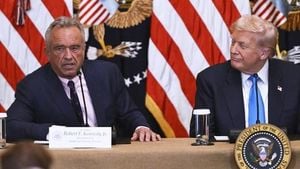On Monday, August 18, 2025, a high-stakes meeting unfolded at the White House, drawing together President Donald Trump, Ukrainian President Volodymyr Zelenskyy, and a cadre of European leaders to address Russia’s ongoing war against Ukraine. But as cameras flashed and world leaders conferred, a pair of unexpected details stole the spotlight—one was a public gaffe by the president himself, and the other was the absence of a signature accessory from Press Secretary Karoline Leavitt, raising questions and sparking commentary far beyond the Oval Office.
The gathering, described by NATO Secretary General Mark Rutte as a "successful" event and Trump as a "pragmatic peacemaker," was intended to send a unified message about the West’s commitment to peace in Eastern Europe. Yet, as reported by multiple sources including The Mirror and Fox News, the meeting’s tone was interrupted when President Trump, now 79 and the oldest U.S. president ever elected, appeared momentarily confused about the identity of Finland’s President Alexander Stubb, who was seated directly across from him.
"President Stubb of Finland … and he’s somebody that we’re all, huh, huh where, where?" Trump asked, his gaze wandering the room even as Stubb sat just two feet away. Stubb, quick on his feet, replied, "I’m right here." Trump, seemingly unfazed, responded, "Oh, you look better than I’ve ever seen you look." The exchange, witnessed by leaders and staff alike, set social media abuzz. Threads users called it a "total embarrassment," with one remarking, "Imagine if this same thing happened with Biden," and another adding, "This man is completely oblivious."
This wasn’t the only recent misstep to fuel speculation about Trump’s mental acuity. Just days before the White House summit, Trump had met with Russian President Vladimir Putin in Alaska on August 15, 2025, as part of ongoing efforts to find a diplomatic solution to the Russia-Ukraine conflict. Yet, in the lead-up to the Alaska talks, the president made several statements suggesting he was unclear about Alaska’s status as a U.S. state. During press conferences, he repeatedly said he was "going to Russia." Press Secretary Karoline Leavitt attempted to clarify the confusion, explaining that Trump was, in fact, heading to Alaska, but the damage was done. On Fox News’ "Special Report with Bret Baier," Trump further muddied the waters, saying, "If it’s bad, if it’s something I don’t see a future in, I’m gone, I’ll leave. I’ll go back to the United States."
These incidents have prompted renewed scrutiny of Trump’s age and cognitive sharpness. While he’s set records as the oldest president to take office, his tendency for public flubs is not new. During his first term, he once thanked his wife, Melania, for her support during a hurricane relief visit—while she stood right beside him. Earlier this month, at a White House press conference with Apple CEO Tim Cook, Trump thanked Cabinet members as if they were absent, only to be gently corrected. Commerce Secretary Howard Lutnick, standing directly behind Trump, interjected, "I’m right behind you," prompting Trump to joke, "Oh, hey, fellas, I missed you."
Despite these moments, the August 18 summit pressed forward, with European leaders and President Zelenskyy focused on the urgent matter at hand: Russia’s war on Ukraine. According to The Mirror, the meeting was part of a broader diplomatic initiative, coming just a week after Trump’s Alaska meeting with Putin. The White House, keen to project unity and resolve, highlighted the participation of key figures from across Europe.
Yet, another detail caught the attention of Washington watchers and fashion aficionados alike: Karoline Leavitt, the 27-year-old White House Press Secretary, was missing her trademark silver cross necklace—a piece she’s rarely seen without. On August 19, Leavitt shared photos from the summit on Instagram, captioning them, "August 18, 2025. President Trump meets with Ukrainian President Zelensky and European leaders in the Oval Office." In the images, Leavitt appeared stylish in a fitted red dress, but her usual necklace was conspicuously absent.
Trang Do, founder of the bespoke jewelry brand Kimjoux, weighed in on the possible significance of Leavitt’s decision. Speaking to The Mirror, Do explained, "Jewelry has long served as more than a simple accessory, instead it is a language of identity, memory, and meaning. Karoline Leavitt’s choice to wear a silver cross necklace is a subtle yet powerful statement that bridges personal narrative with cultural symbolism, and she’s rarely seen without it."
Do continued, "Jewelry often acts as an emotional anchor, so its removal, particularly when noticeable, can reflect a shift. In this case, not wearing the cross could signal a moment of quiet transformation. Perhaps it’s a deliberate decision to step away from certain associations, whether religious, cultural, or personal. It might indicate a desire to assert independence from expectations, or even a readiness to embrace vulnerability without the comfort or protection the piece once offered. Of course, sometimes the absence is practical or coincidental. But with someone like Karoline, whose choices are often intentional and tightly curated, the decision to forgo a symbolic item like this necklace could be a conscious decision and one that shows her stepping away from a look that we’re previously used to seeing her in."
While Leavitt herself did not comment on her missing accessory, her presence at the meeting was notable. In one image, she’s seen addressing the assembled leaders; in another, she sits quietly at the back of the room as Trump speaks. The absence of her necklace became a talking point in its own right, with speculation ranging from practical reasons to deeper, more personal motivations.
As the dust settles from a week of high-profile diplomacy and headline-grabbing moments, the White House finds itself at the center of both international intrigue and domestic curiosity. Trump’s gaffes—whether momentary lapses or signs of something deeper—continue to fuel debate about his leadership as he navigates the final years of his presidency. Meanwhile, even the smallest changes in the routines of his inner circle, like Leavitt’s missing necklace, are parsed for meaning in a town where symbolism often speaks as loudly as policy.
In the end, the August 18 meeting may be remembered as much for its unscripted moments as for its diplomatic outcomes, offering a revealing glimpse into the personalities and pressures shaping American leadership at a critical juncture in world affairs.




